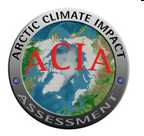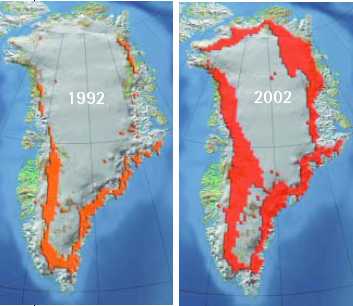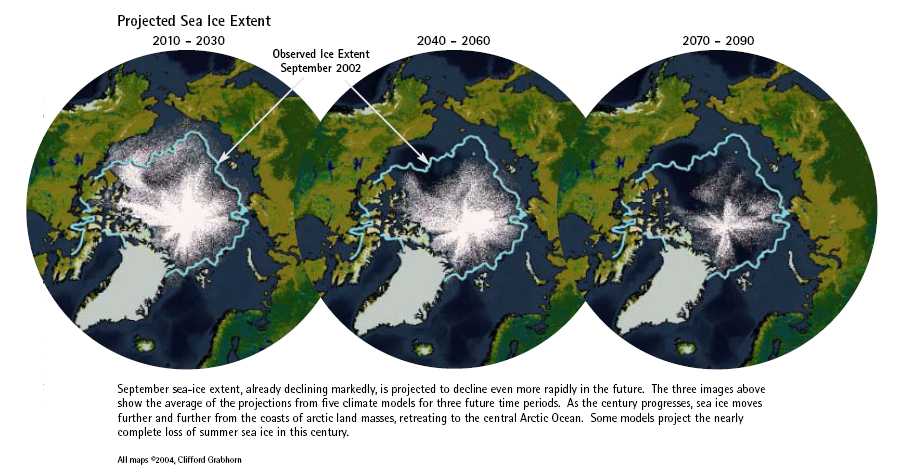|
Bericht van ACIA
Arctic Climate Impact Assessment
NEWS
November 8, 2004
Contact:
http://www.acia.uaf.edu
New Scientific Consensus: Arctic Is Warming Rapidly
Much larger changes are projected, affecting global climate
REYKJAVIK—The Arctic is warming much more rapidly than previously
known, at nearly twice the rate as the rest of the globe, and
increasing greenhouse gases from human activities are projected to
make it warmer still, according to an unprecedented four-year
scientific study of the region conducted by an international team of
300 scientists.
At least half the summer sea ice in the Arctic is projected to melt by
the end of this century, along with a significant portion of the
Greenland Ice Sheet, as the region is projected to warm an additional
4-7? C (7 to 13? F) by 2100. These changes will have major global
impacts, such as contributing to global sea-level rise and
intensifying global warming, according to the final report of the
Arctic Climate Impact Assessment (ACIA).
The assessment was commissioned by the Arctic Council (a ministerial
intergovernmental forum comprised of the eight Arctic countries and
six Indigenous Peoples organizations) and the International Arctic
Science Committee (an international scientific organization appointed
by 18 national academies of science).
The assessment’s findings and projections are being released today and
will be presented in detail at a scientific symposium in Reykjavik,
Iceland, November 9-12, 2004.
The assessment’s projections are based on a moderate estimate of
future emissions of carbon dioxide and other greenhouse gases, and
incorporate results from five major global climate models used by the
Intergovernmental Panel on Climate Change (IPCC).
“The impacts of global warming are affecting people now in the Arctic,”
says Robert Corell, chair of the ACIA. “The Arctic is experiencing
some of the most rapid and severe climate change on earth. The impacts
of climate change on the region and the globe are projected to
increase substantially in the years to come.”
A Few Selected Findings
• In Alaska, Western Canada, and Eastern Russia average winter
temperatures have increased as much as 3-4? C (4 to 7?F) in the past
50 years, and are projected to rise 4-7? C (7-13?F) over the next 100
years.
• Arctic summer sea ice is projected to decline by at least 50 percent
by the end of this century with some models showing near-complete
disappearance of summer sea ice. This is very likely to have
devastating consequences for some arctic animal species such as
ice-living seals and for local people for whom these animals are a
primary food source. At the same time, reduced sea ice extent is
likely to increase marine access to some of the region’s resources.
• Warming over Greenland is projected to lead to substantial melting
of the Greenland Ice Sheet, contributing to global sea-level rise at
increasing rates. Over the long term, Greenland contains enough melt
water to eventually raise sea level by about 7 meters (about 23 feet).
• Should the Arctic Ocean become ice-free in summer, it is likely that
polar bears and some seal species would be driven toward extinction.
• Arctic climate change presents serious challenges to the health and
food security of some Indigenous Peoples, challenging the survival of
some cultures.
• Many coastal towns and facilities around the Arctic face increasing
risks from erosion and flooding due to rising sea levels, decreased
sea ice, and thawing coastal permafrost.
• Over the next 100 years, climate change is expected to accelerate,
contributing to major physical, ecological, social, and economic
changes, and the Assessment has documented that many of these changes
have already begun.
The Arctic Climate Impact Assessment was formally initiated in 2000 at
the Ministerial Meeting of the Arctic Council at Point Barrow, Alaska
as a joint project implemented by the Arctic Council’s Arctic
Monitoring and Assessment Programme (AMAP) and Conservation of Arctic
Flora and Fauna (CAFF) Working Groups, and the International Arctic
Science Committee. As specified in the Barrow Declaration, the goal of
the ACIA is to “evaluate and synthesize knowledge on climate
variability and change and increased ultraviolet radiation, and
support policy-making processes and the work of the Intergovernmental
Panel on Climate Change (IPCC).” The Arctic Council directed ACIA to
address “environmental, human health, social, cultural, and economic
impacts and consequences, including policy recommendations.”
|



